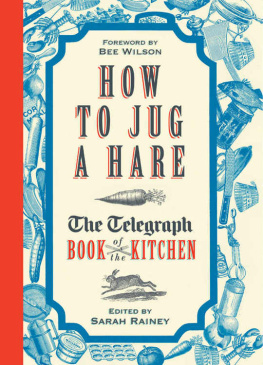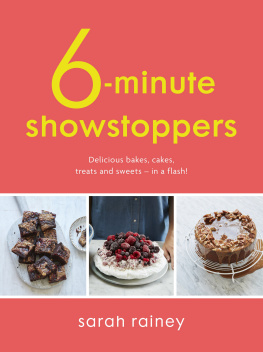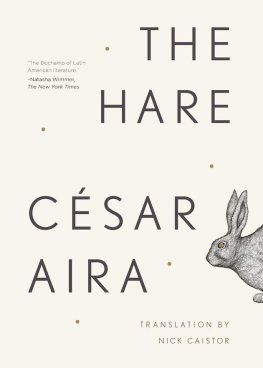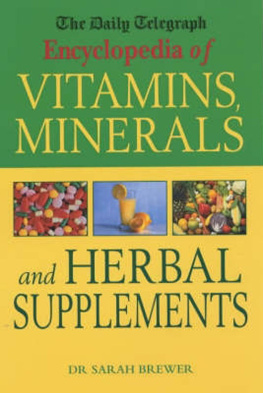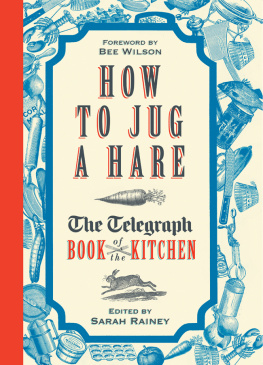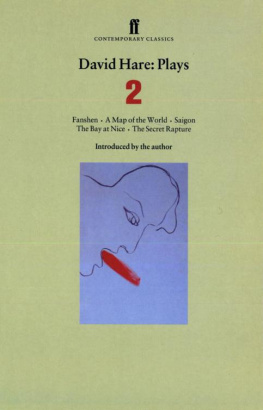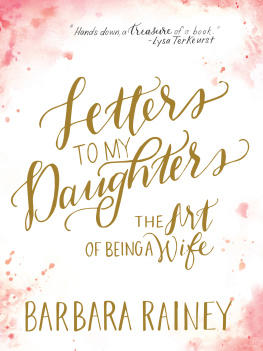Sarah Rainey - How to Jug a Hare: The Telegraph Book of the Kitchen
Here you can read online Sarah Rainey - How to Jug a Hare: The Telegraph Book of the Kitchen full text of the book (entire story) in english for free. Download pdf and epub, get meaning, cover and reviews about this ebook. year: 2015, publisher: Aurum Press Ltd, genre: Non-fiction. Description of the work, (preface) as well as reviews are available. Best literature library LitArk.com created for fans of good reading and offers a wide selection of genres:
Romance novel
Science fiction
Adventure
Detective
Science
History
Home and family
Prose
Art
Politics
Computer
Non-fiction
Religion
Business
Children
Humor
Choose a favorite category and find really read worthwhile books. Enjoy immersion in the world of imagination, feel the emotions of the characters or learn something new for yourself, make an fascinating discovery.
- Book:How to Jug a Hare: The Telegraph Book of the Kitchen
- Author:
- Publisher:Aurum Press Ltd
- Genre:
- Year:2015
- Rating:5 / 5
- Favourites:Add to favourites
- Your mark:
- 100
- 1
- 2
- 3
- 4
- 5
How to Jug a Hare: The Telegraph Book of the Kitchen: summary, description and annotation
We offer to read an annotation, description, summary or preface (depends on what the author of the book "How to Jug a Hare: The Telegraph Book of the Kitchen" wrote himself). If you haven't found the necessary information about the book — write in the comments, we will try to find it.
Sarah Rainey: author's other books
Who wrote How to Jug a Hare: The Telegraph Book of the Kitchen? Find out the surname, the name of the author of the book and a list of all author's works by series.
How to Jug a Hare: The Telegraph Book of the Kitchen — read online for free the complete book (whole text) full work
Below is the text of the book, divided by pages. System saving the place of the last page read, allows you to conveniently read the book "How to Jug a Hare: The Telegraph Book of the Kitchen" online for free, without having to search again every time where you left off. Put a bookmark, and you can go to the page where you finished reading at any time.
Font size:
Interval:
Bookmark:
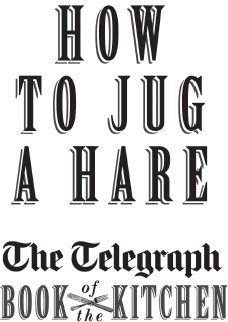
Edited by Sarah Rainey
Foreword by Bee Wilson

Contents
Bee Wilson
Fanny Cradock had strong views on fruit, as she did on so much else. On 23 June 1970, the colourful TV cooks Bon Viveur column in the Daily Telegraph co-written with husband Johnnie was headlined Simply, Strawberries. Berries were best unadorned, Cradock proclaimed, assuming, that is, that certain rather fierce rules were obeyed. Where a modern recipe writer might worry about how to buy a variety of strawberries that were sweet enough, and not bland or mushy, Cradock was more concerned with the cream and the sugar. Let us serve them with cream and sugar, but let the cream be farm fresh and not that absolutely tasteless shop stuff which has to be tiddled up (otherwise all it provides is density) and let the sugar be that pale, beige, sand-textured... sugar which anyone can get if they try.
The person reading this feels admonished. Note to self: try harder when buying cream and sugar.
But Cradocks strawberry column which also includes an enticing recipe for choux buns filled with homemade strawberry ice cream epitomises the particular pleasure and power of newspaper food writing, which is quite unlike that of a cookbook. In essence this hasnt changed much from 1970 to today and can be summed up in a single word: timing. Cookbooks may very well include strawberry recipes but the author has no idea when if ever anyone will try them. By contrast, Fanny Cradockknew that, this being two days after midsummer, Telegraph readers would already have strawberries on their mind, and be primed for guidance on the matter of cream and sugar. For those unfortunates who had only shop cream and bog-standard caster sugar in the house, she helpfully suggested using them to make an orange sauce, remarking that oranges and strawberries had a great affinity.
Many aspects of the Telegraph food pages have been transformed over the years, as the book in your hands vividly reminds us. There is not so much talk these days of housewives and the problems they face at the fishmonger, a subject of debate in 1937. Quinoa, lime and coriander feature far more often than in the past; and jugged hare, less so. Nor do you see articles on fare for convalescents, a subject from 1915, when the First World War made the question of feeding the wounded and the sick a pressing concern. That year, the papers food correspondent warned that new potatoes could be disastrous to a convalescent, but looked favourably on calves brains and feet and sheeps tongues cooked fresh, and tripe. Another article, from 1925, recommends a marvellous new food called Marmite as specially useful in cases of influenza and severe chill and even beneficial to those troubled with sleeplessness.
One thing that hasnt changed, however, is the unique power that newspapers have for keeping readers company in the kitchen. Unlike with a cookbook, which doesnt hear you when you scream at it I am forever getting annoyed with recipes that miss out ingredients, or stipulate the wrong-sized cake tin a newspaper offers the chance to become part of the cooking conversation. Just this week, I had a letter from a reader complaining that I was an idiot for thinking it was possible to make Yorkshire pudding with oil when, obviously, only beef dripping would do. Since the early days, Telegraph readers have also contributed their own recipes.
These readers teatime recipes appeared in October, when the return to the fireside gives new importance to teatime entertaining, as the food editor put it. The great advantage of writing almost in real time is the ability to respond to the changes in the food calendar as they happen, whether its the yearly transition from summer to autumn or larger changes in dietary habits. In 1980, Marika Hanbury-Tenison, the Sunday Telegraph cook for many years, said: People always ask me how I manage to think up something to say week after week. I regularly get asked the samequestion about my Kitchen Thinker column in Stella, and my answer would echo Tenisons, who said: My problem is that I have too much to say... every single day I make some discovery working in my kitchen that I feel must be shared.
One of the areas that food has changed most dramatically over the papers history is in technology. As kitchens modernised, the papers food writers have tried to make sense of such puzzling new developments as the fridge, the three-tiered steamer and the microwave. Such a revolutionary new way of cooking does have its mysteries, warned Ann Chubb in 1983, before recommending some terracotta-coloured plastic dishes and a cooking course at the microwave cookery school in London.
The newspaper medium encourages a taking of the temperature of where we stand on certain matters: a standard setting for such questions as the ethics of veal, the virtues (or otherwise) of low-fat cooking and a decision as to whether ready-made marzipan is ever acceptable. In 1982, in a column on Simnel cake, Denis Curtis was more tactful than Fanny Cradock had been on the question of shop cream, but still made his preference for home-made marzipan quite clear. You can buy very good pure almond paste ready made, he began, but for this cake pound 1 lb sweet almonds till quite smooth with a little rose water. Mix in lb icing sugar and as much beaten egg as will bind it.
The food pages have also been the ideal place to explore changing tastes in cuisine. Again, its about timing, as certain ingredients and indeed whole countries pass in and out of favour. In 1931, X. M. Boulestin was urging Telegraph readers to eat the natural and balanced diet of the French, for the sake of health as well as pleasure (before giving a recipe for chicken and foie gras in pastry). The current Telegraph food sections feature extraordinary recipes from globe-trotting chefs, especially from Diana Henry and Stevie Parle, who plunder the world for the most intense flavours, from Scandinavia to Korea. Their writing continues in the tradition of Claudia Roden, who introduced readers to all manner of foreign food.
Its a big leap to choose to buy a whole book of recipes from Turkey, say (though if you change your mind, try Ghillie Baan), but newspaper food writing gives you none of that heavy feeling of I really ought to cook this, and this, and this that sometimes descends when perusing one of the latest cookery bibles. You open a newspaper in a different, more casual frame of mind. Recipes appear as a bonus, or a gift. No obligation.You are free to tear out and keep the things that catch your eye and discard the rest.
Newspapers have a curious ability to be both ephemeral and permanent. Although they belong to a particular moment, the torn-out recipes that you keep are often referred back to for years, if not decades. Most good cooks I know have a store of dog-eared treasures from weekend supplements, either stuffed in the end pages of a cookbook or if they are organised laminated and filed away. Ive noticed that the most cherished are those that relate most strongly to the passing of the seasons: a stash of damson recipes for the autumn, say, or hearty puddings for the winter. The Telegraph recipes I have clipped the most by a long way are Christmas ones: Tamasin Day-Lewiss mincemeat, Rowley Leighs bread sauce, Diana Henrys perfect crunchy roast potatoes. Christmas seems to arrive sooner every year. There is always the turkey to roast or an alternative feast to dream up the pudding to make, the sprouts to cook in such a way that the festive mood is not dented. It is now that food writers can offer just what you are looking for. Its timing, again. Id never have dared to brine my turkey in a bucket had I not read Elisabeth Luard describing it in the
Next pageFont size:
Interval:
Bookmark:
Similar books «How to Jug a Hare: The Telegraph Book of the Kitchen»
Look at similar books to How to Jug a Hare: The Telegraph Book of the Kitchen. We have selected literature similar in name and meaning in the hope of providing readers with more options to find new, interesting, not yet read works.
Discussion, reviews of the book How to Jug a Hare: The Telegraph Book of the Kitchen and just readers' own opinions. Leave your comments, write what you think about the work, its meaning or the main characters. Specify what exactly you liked and what you didn't like, and why you think so.

